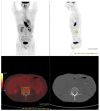Prognostic Value of Bone Marrow Uptake Using 18F-FDG PET/CT Scans in Solid Neoplasms
- PMID: 36354870
- PMCID: PMC9692285
- DOI: 10.3390/jimaging8110297
Prognostic Value of Bone Marrow Uptake Using 18F-FDG PET/CT Scans in Solid Neoplasms
Abstract
Background: Fluorine-18-fluorodeoxyglucose positron emission tomography/computerized tomography (18F-FDG PET/CT) uptake is known to increase in infective and inflammatory conditions. Systemic inflammation plays a role in oncologic prognosis. Consequently, bone marrow increased uptake in oncology patients could potentially depict the systemic cancer burden.
Methods: A single institute cohort analysis and a systematic review were performed, evaluating the prognostic role of 18F-FDG uptake in the bone marrow in solid neoplasms before treatment. The cohort included 113 esophageal cancer patients (adenocarcinoma or squamous cell carcinoma). The systematic review was based on 18 studies evaluating solid neoplasms, including gynecological, lung, pleura, breast, pancreas, head and neck, esophagus, stomach, colorectal, and anus.
Results: Bone marrow 18F-FDG uptake in esophageal cancer was not correlated with staging, pathological response, and survival. High bone marrow uptake was related to advanced staging in colorectal, head and neck, and breast cancer, but not in lung cancer. Bone marrow 18F-FDG uptake was significantly associated with survival rates for lung, head and neck, breast, gastric, colorectal, pancreatic, and gynecological neoplasms but was not significantly associated with survival in pediatric neuroblastoma and esophageal cancer.
Conclusion: 18F-FDG bone marrow uptake in PET/CT has prognostic value in several solid neoplasms, including lung, gastric, colorectal, head and neck, breast, pancreas, and gynecological cancers. However, future studies are still needed to define the role of bone marrow role in cancer prognostication.
Keywords: bone marrow; esophageal neoplasms; neoadjuvant therapy; nuclear medicine; positron emission tomography.
Conflict of interest statement
The authors declare no conflict of interest.
Figures





Similar articles
-
More advantages in detecting bone and soft tissue metastases from prostate cancer using 18F-PSMA PET/CT.Hell J Nucl Med. 2019 Jan-Apr;22(1):6-9. doi: 10.1967/s002449910952. Epub 2019 Mar 7. Hell J Nucl Med. 2019. PMID: 30843003
-
Prognostic Significance of FDG Uptake of Bone Marrow on PET/CT in Patients With Non-Small-Cell Lung Cancer After Curative Surgical Resection.Clin Lung Cancer. 2017 Mar;18(2):198-206. doi: 10.1016/j.cllc.2016.07.001. Epub 2016 Jul 9. Clin Lung Cancer. 2017. PMID: 27495385
-
Prognostic value of metabolic indices and bone marrow uptake pattern on preoperative 18F-FDG PET/CT in pediatric patients with neuroblastoma.Eur J Nucl Med Mol Imaging. 2018 Feb;45(2):306-315. doi: 10.1007/s00259-017-3851-9. Epub 2017 Nov 7. Eur J Nucl Med Mol Imaging. 2018. PMID: 29110068
-
Correlation between the Uptake of 18F-Fluorodeoxyglucose (18F-FDG) and the Expression of Proliferation-Associated Antigen Ki-67 in Cancer Patients: A Meta-Analysis.PLoS One. 2015 Jun 3;10(6):e0129028. doi: 10.1371/journal.pone.0129028. eCollection 2015. PLoS One. 2015. PMID: 26038827 Free PMC article.
-
Detection of distant interval metastases after neoadjuvant therapy for esophageal cancer with 18F-FDG PET(/CT): a systematic review and meta-analysis.Dis Esophagus. 2018 Dec 1;31(12). doi: 10.1093/dote/doy055. Dis Esophagus. 2018. PMID: 29917073
Cited by
-
Baseline 18F-FDG PET/CT for predicting pathological response to neoadjuvant chemotherapy and prognosis in locally advanced breast cancer patients: analysis of tumor and lymphoid organs metabolic parameters.Radiol Med. 2025 Mar;130(3):422-437. doi: 10.1007/s11547-025-01961-9. Epub 2025 Feb 12. Radiol Med. 2025. PMID: 39937369
-
FDP/FIB ratio serves as a novel biomarker for diagnosing bone marrow invasion in gastric cancer and predicting patient prognosis\.Sci Rep. 2025 Mar 19;15(1):9462. doi: 10.1038/s41598-025-93056-8. Sci Rep. 2025. PMID: 40108276 Free PMC article.
References
-
- Boellaard R., Delgado-Bolton R., Oyen W.J., Giammarile F., Tatsch K., Eschner W., Verzijlbergen F.J., Barrington S.F., Pike L.C., Weber W.A., et al. FDG PET/CT: EANM procedure guidelines for tumour imaging: Version 2.0. Eur. J. Nucl. Med. Mol. Imaging. 2015;42:328–354. doi: 10.1007/s00259-014-2961-x. - DOI - PMC - PubMed
LinkOut - more resources
Full Text Sources

